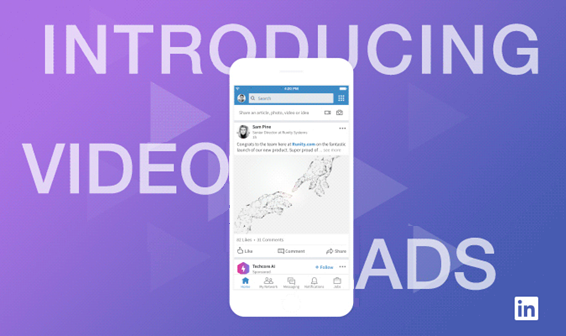You may have seen company videos appearing on LinkedIn recently. With the right video content, brands can now use sight, sound and motion to tell compelling stories, and drive deeper engagement on LinkedIn feeds and individual and company updates.
LinkedIn update results tracking, introduced in May 2015, allowed marketers to track how their LinkedIn updates matched with their website traffic. Video was the obvious next step, and video for individuals launched on LinkedIn in August 2017, and the results achieved by early adopters of video on the popular business social media platform have been very encouraging.
As of July 2018, LinkedIn launched video for their Sponsored Content and Company Pages. This is no surprise because, in a busy world, we’d all rather watch an interesting video rather than read through even a short amount of text and then click on a link to find out more.
In 2017 there was a 17% growth in the use of video by businesses globally, and that’s not a huge revelation given how easy it is to create sharp, high resolution video these days. We’ve all seen those adverts during the World Cup encouraging us to be film producers on our iPhones (other phones with video facilities are available).
The barrier for entry when it comes to video creation has been dramatically lowered by the advent of these high-res smartphone cameras, inexpensive accessories and simplified mobile, laptop or cloud editing software.
Creating LinkedIn video ads
81% of businesses are now using video as a primary marketing tool, and marketing departments in all sizes of business can now create quality video content without needing the sort of specialised resources and post production video editing that was once required.
With the cost to entry being so low, it’s almost a question of ‘why wouldn’t you?’ rather than the other way around. However, independent filmmaker C. Mason Wells hit the nail on the head when he was asked about the greatest challenges in cinema today. He said:
“The act of making movies has never been easier, but getting people to care about them has never been harder.”
This is certainly a lament that rings true in the world of video marketing. But, as with any type of content in our highly saturated digital environment, the struggle is to both find and captivate the right audience for your products or services. This has been especially true for B2B marketers, who haven’t had an ideal platform for sharing and amplifying their business-related videos. Whilst most marketers use YouTube or Vimeo to host their B2B videos, they rely on search for these on the video channels to drive traffic to their website and to encourage customers to buy what they sell.
Until now. There is no doubt that all B2B marketers see LinkedIn as a primary social media tool to reach a business audience, whether through the carefully developed networks they’ve honed since LinkedIn launched in 2003, or through the company channels that they manage.
The jury is still out on what types of video will ultimately work best on LinkedIn, as all new features on social media platforms often involve some level of experimentation and guesswork.
But there are some relatively straightforward guidelines to follow to help your brand and company succeed with LinkedIn video ads.
- Choose a campaign objective tied it to your video marketing approach
- Consider your ROI and measure progress against that objective
- Follow best practice for social video (length, sound, structure etc.)
- Find a ‘sweet spot’ in terms of audience target and campaign budget
- Drive follow-up action with a clear and enticing Call To Action (CTA)
- Test and optimise your campaign videos for continual improvement
LinkedIn video features
Native video ads represent an evolution of LinkedIn Sponsored Content, letting you engage with business decision makers throughout their buying journey on LinkedIn. Unlike pre-roll or post-roll video ads, video for Sponsored Content lives directly in the news feed as a standalone post.
Video for Sponsored Content helps you achieve your marketing objectives by:
- Building brand awareness – telling rich, visual stories via social media
- Driving qualified traffic direct to desktop or mobile website pages
- Collect high-quality leads with a persistent “call to action” button
- Utilise LinkedIn’s integrated Lead Gen Forms product for leads
But without accurate targeting, your ads won’t be seen by the right audiences. With LinkedIn’s suite of B2B targeting capabilities available for video for Sponsored Content, you can find your audience by traits like job title, seniority, company name, industry, skills etc. What’s more, the integration with Matched Audiences ensures you can target your Sales team’s highest-priority accounts with account-based marketing (ABM) campaigns.
Since LinkedIn launched the private beta in October 2017, over 700 advertisers including GE, Philips and Audi Canada have tested video for Sponsored Content to highlight not only their products and services, but also their company mission, customer success stories and thought leadership content. These videos are helping marketers deepen brand engagement as, on average, LinkedIn members spend almost 3x more time watching video ads compared to time spent with static Sponsored Content.
“Video content is crucial for our brand, allowing LinkedIn’s professional community to more easily derive value from the content we are producing. While our videos can be up to 3 minutes, we are seeing deep engagement at a great value.”
Kaydee Bridges, Vice President, Digital & Social Media Strategy, Goldman Sachs.
All marketers understand that everything hinges on delivering greater ROI. With video for Sponsored Content, you can measure campaign success through insights and detailed breakdowns about the types of professionals watching, engaging with and even converting on your video ads. LinkedIn’s proprietary Conversion Tracking tool is also integrated, enabling you to measure the number of leads, sign-ups, website visits, and other valuable actions that your video content generates.
“Video stands out because it doesn’t tell, but it shows. On a platform where there’s more business content, a video stands out more, especially on LinkedIn.”
Renske Siersema, Social Media Manager at KLM Royal Dutch Airlines
Conclusion
When it comes to creating your great B2B video content, well that’s entirely down to you. But when it comes to getting the right people to notice and care about those videos, there’s no doubt that LinkedIn can now help your brand get your products, benefits and values across more easily to your target audience.
- Download the LinkedIn advert video guide – click here



